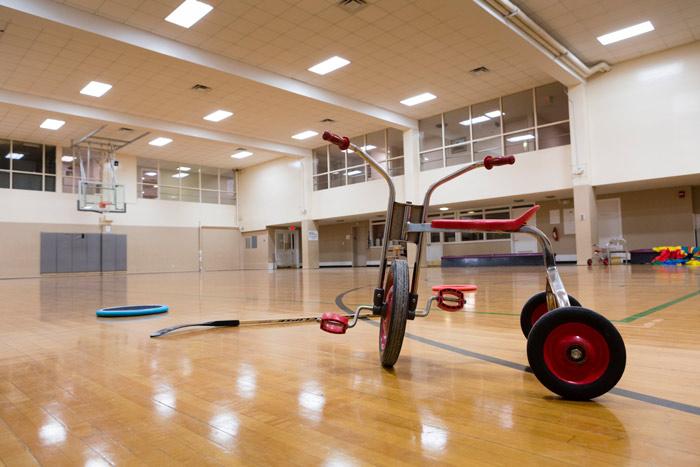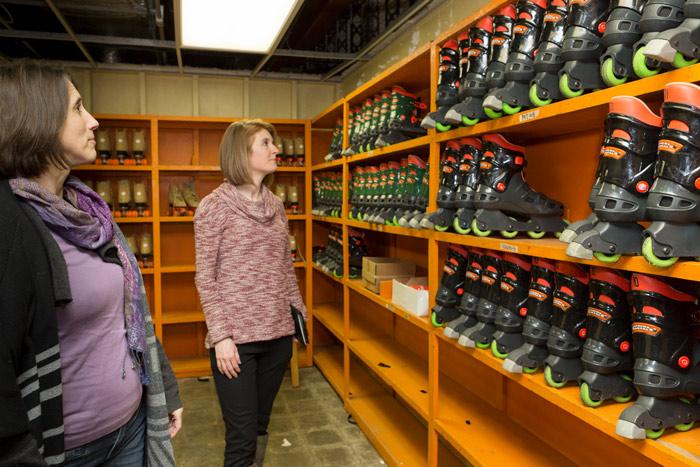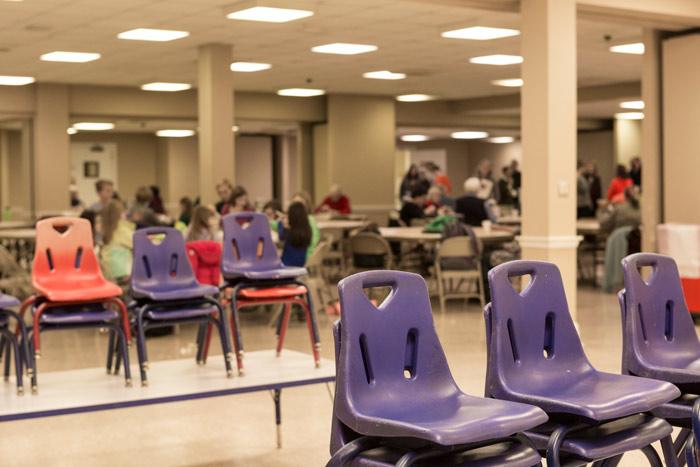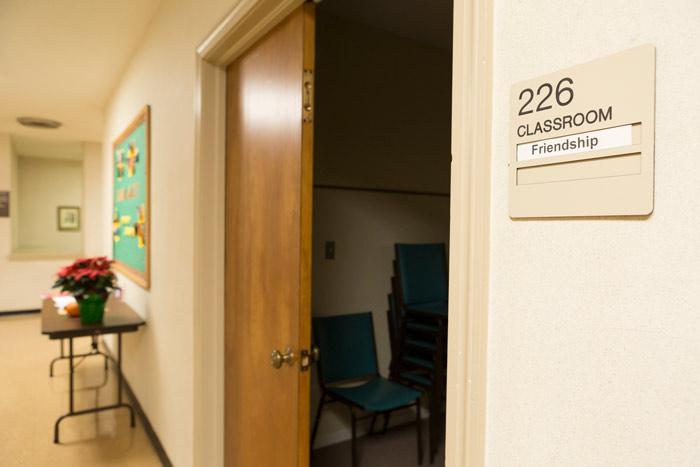The pandemic has wreaked havoc on working women. U.S. workforce data attests that the economic and employment impact has fallen disproportionately on women, particularly mothers also juggling child care responsibilities and school closures. Many are leaving the workforce.
There are no good figures on the number of clergywomen who have quit as a result of the pandemic, but Christian leaders say the coronavirus has exacerbated the already-stressful lives of women clergy. Many have reported exhaustion, burnout and decision fatigue from the prolonged struggle to care for their congregations, their households and, in many cases, communities combatting racism and anti-Asian violence that arose in response to the illness.
Lori Nelson, who as chief resilience officer for the city of Boston often works with clergywomen to help underserved communities overcome social and economic challenges, has seen this pressure up close. “What was clear is that they were still leading but also very taxed,” she said.
In many cases, clergywomen — particularly women of color — have functioned like first responders on the front lines of the pandemic, said the Rev. Laura Everett, the executive director of the Massachusetts Council of Churches.
“What we sometimes miss among clergy of color is the additional communal responsibility put on clergy colleagues to do communal and explanatory work in times of social change,” Everett said.
The stressors are particularly acute on women clergy serving small congregations with 100 or fewer members, where there is no other professional or paid staff to carry the burden, as well as on bivocational pastors managing commitments to other jobs.
“There was an urgency of being very well educated and informed about what this was,” said Nelson. “Then it was how you survive through it, the do’s and don’ts. Then how do you begin to message the importance of getting vaccinated, recognizing the stereotypes and stigmas and experiences of people of color.”
Even as their personal lives have grown more chaotic, many have responded by ramping up their outreach. For example, the Rev. Liz Walker of Roxbury Presbyterian, a small church in the middle of a mostly Black Boston neighborhood, partnered with another local clergywoman to start a series of vaccine education webinars. They landed Dr. Anthony Fauci, the director of the National Institute of Allergy and Infectious Diseases, as a guest for the first installment, drawing 2,800 online visitors.
The webinars, plus a weekly session the church offers for people overcoming trauma, are ongoing.
“I think we worked harder,” said Walker, who is well known in the community as a former Boston TV news anchor.
“The women I’ve worked with are very tired and very weary, but not giving up.”
The following are the pandemic stories of four women clergy — mothers, pastors and, in two cases, bivocational ministers — who lead small churches.
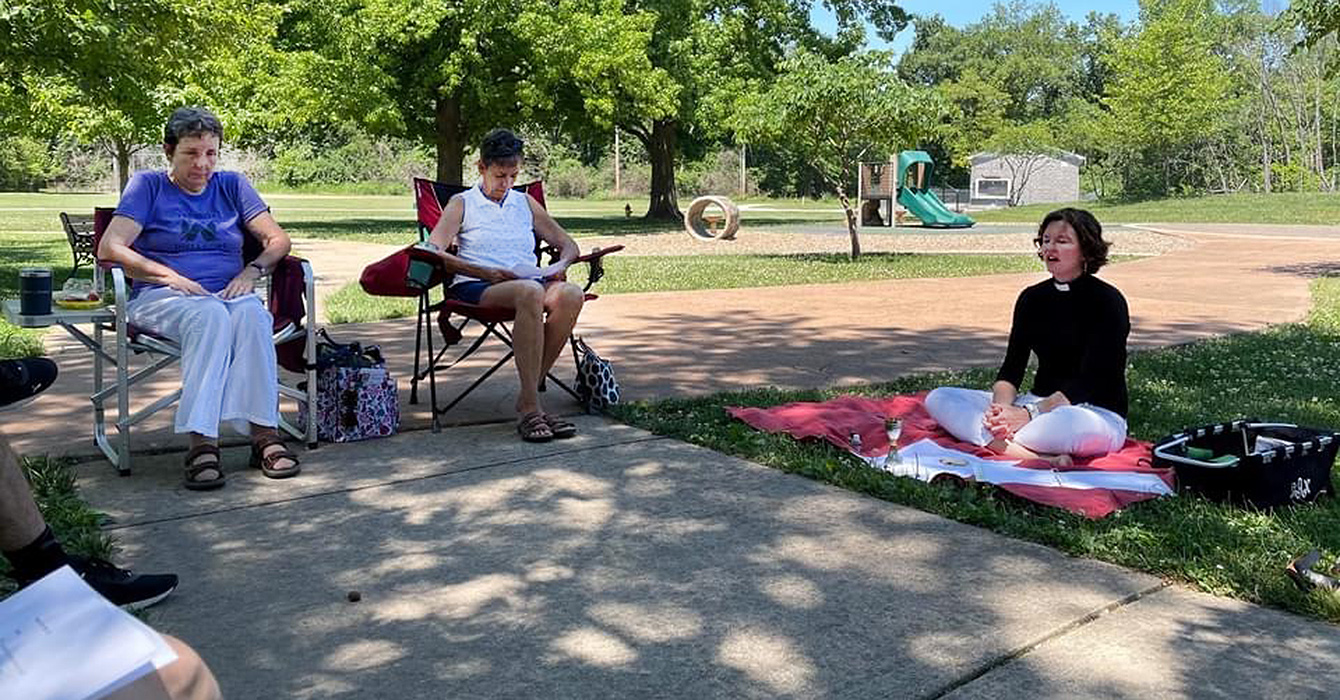
The Rev. Laurie Anzilotti: When home and work collide
During the early days of the pandemic, to escape the commotion in her home, Laurie Anzilotti began leading Zoom church services from her front porch.
One day, as she was conducting a funeral service from the porch, one of her four children came running outside shouting, “Mom, where are the hot dogs?!”
The moment captured a common experience of the pandemic: the disruption and chaos that result when the public and private spheres of work and home collide.
For Anzilotti, the vicar of St. Francis’ Episcopal Church, a mission of the Episcopal Diocese of Missouri, life at the height of the pandemic was messy, disjointed and occasionally awkward.
It was also stressful. Anzilotti’s husband, Craig, a dentist, was forced to shut down his business, leaving 14 full-time employees in limbo. Her four children, including a 15-year-old daughter with Williams syndrome, were all studying online at home.
In addition to caring for them, Anzilotti tried to attend to her 120 parishioners.
“I had the sense that I was always working and never working, always taking care of my house and my family and never taking care of my house and my family,” she said. “It was all happening in the same space all the time. There was no differential between the two.”
After the online funeral interruption, she instituted some changes, including a simple color-coded signal she set out for her family — a clipboard displaying a red paper when she was not to be disturbed, a yellow one when a brief interruption was OK, or a green one for, “I’m working, but I’m happy to entertain whatever question or conversation you want to have.”
Solving the isolation and loneliness of her parishioners took more time. Eventually, Anzilotti started offering drive-in Eucharist in the parking lot next to the church. Church members remained in their cars and were able to tune in to the service on an FM radio frequency.
It may seem that a smaller congregation means less work, but this is far from the truth. What other assumptions are we making about smaller congregations and their pastors?
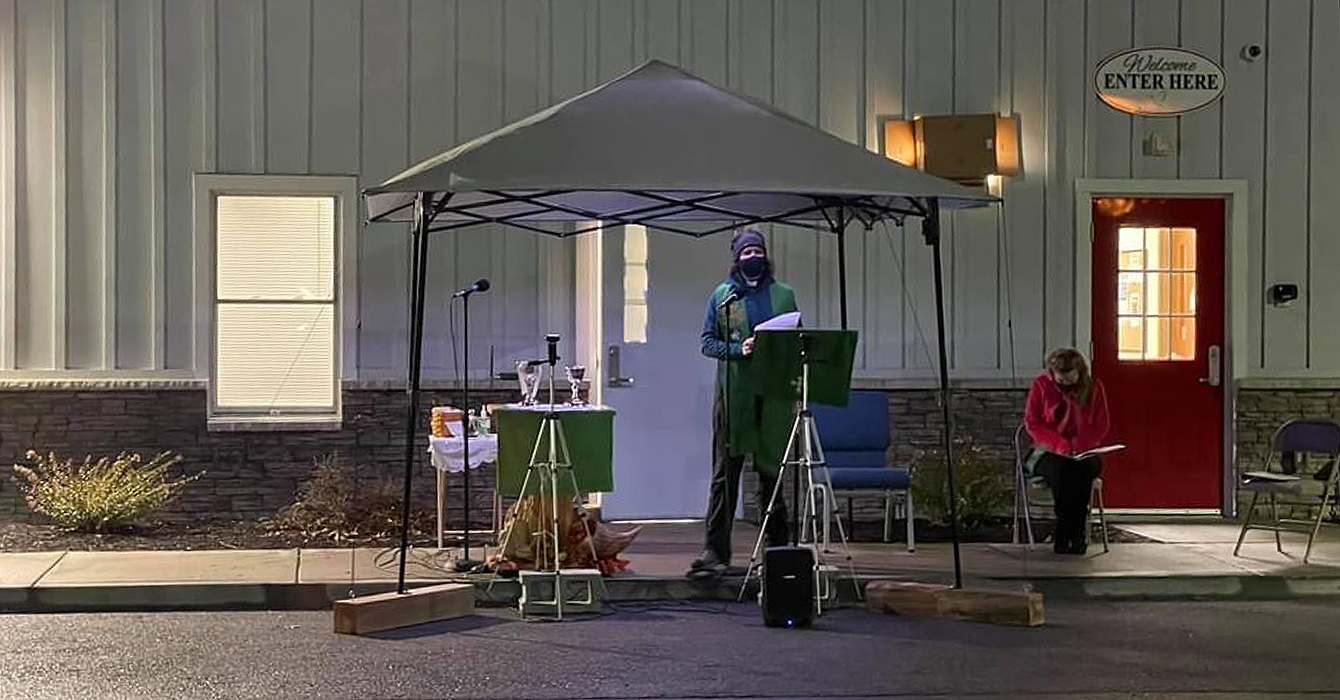
But her happiest innovation was a Wednesday noontime Eucharist service at a city park. She typically arrived around 11:45 a.m. to lay out a white tablecloth on a picnic table and distribute a psalm to those gathering around her.
The short service included a Bible reading, a short lectio divina, in which Anzilotti asked participants what word, thought, phrase or image spoke to them from the reading. She then followed with prayers for the people and the Eucharist.
“It’s very simple, but it’s one of the most profound spiritual times of my week,” she said.
This summer, indoor services have resumed at St. Francis’. Most of Anzilotti’s kids are away at camp. Her husband and his 14 employees are back at work. But the Wednesday park Eucharist continues.
Recently, the congregation planted six trees in the church’s memorial garden to remember those who have died in the pandemic. (Only one church member has died from COVID-19.)
Now comes the work of healing.
“One of the roles for us as safe communities is to give people spaces to process grief,” Anzilotti said. “I want to make sure they’re reflecting on the past 16, 17 months and doing any grief work they need to do and lifting people up in prayer.”
How is your particular congregation marking this season of challenge and loss? Is your community offering spaces for congregants to process grief?
The Rev. Gabrielle Kennedy: The body of Christ is bigger than one church
Gabrielle Kennedy has worked at the intersection of faith and health for nearly her whole career. But at no time have the two areas come together as forcefully as during the pandemic.
Kennedy was assigned to her first church, Buren Chapel AME, in Herculaneum, Missouri, only a few months before the pandemic hit. At the same time, she was hired as a congregational coordinator at Faith & For the Sake of All, a St. Louis nonprofit committed to improving the health and well-being of the city’s African Americans, where she now serves as executive director.
The organization was founded in response to a landmark 2014 study on the health disparities faced by African Americans in St. Louis, called For the Sake of All. Among the study’s stark findings was a difference in life expectancy between Black and white residents living only a few miles apart of up to 18 years. The nonprofit’s mission is to mobilize faith communities to narrow the divide and to create an unarmed crisis-response team in Lynn.
With the pandemic, the long-standing disparities grew even more evident, as African Americans became twice as likely as white Americans to die of COVID-19, according to the Centers for Disease Control and Prevention.
“We were now living the data in real time,” said Kennedy, 51.
In addition to caring for members of her own small church, Kennedy took it upon herself to educate the larger church community about the coronavirus and how to stay healthy.
When she realized that Black people in her community didn’t have the same access to testing, Faith & For the Sake of All partnered with a federally qualified health center to offer pop-up testing sites in churches. The initiative was able to reach members of 22 congregations, either predominantly Black or in Black communities.
As she was working on the first testing campaign, both her husband, Wayne, and her younger son, Jahbari, then 17, contracted the virus. Wayne Kennedy spent nearly two weeks in the hospital and then a long recuperation at home.
“We all slept in different rooms,” she said. “I had to make all their meals and take it to them.”
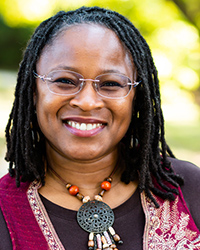
Church members, friends, family and neighbors helped with grocery shopping, cleaning supplies and prayers.
“It was the greatest example of charity I’ve received,” Kennedy said. “It was very humbling.”
Both her family members have since recovered — and Kennedy has taken up a new challenge. Getting people tested was hard work, she found, but persuading church members to get vaccines is harder.
“One thing that became apparent is that the vaccine hesitancy in communities of color was not only about vaccines,” she said. It was also about a lack of trust in government and in the health care system to do the right thing by Black people, she said.
She’s still at it, and the pandemic has taught her that churches coming together can be a power for social change. The success of the COVID testing sites is the perfect example.
“The body of Christ is bigger than your church. It’s a vast group of people with varying gifts, spiritual gifts given by God to be used together.”
In what ways does your congregation participate in the larger body of Christ?
The Rev. Sandra Bonnette-Kim: Staying healthy amid related pandemic dangers — COVID-19 and racial discrimination
What she remembers most from the pandemic so far are the funerals.
Sandra Bonnette-Kim estimates that she has officiated at 40 funerals since the lockdown began in March 2020. At first, they were infrequent. But beginning in December last year, they came fast and furious — one or two a week.
“It got to a point where I told the funeral director, ‘I’ll see you next week,’” she said.
Not all were COVID-19-related deaths. Bonnette-Kim’s congregation, Grace United Methodist Church in Lynn, Massachusetts, had less than a handful of coronavirus deaths, all elderly nursing home residents.
But in this racially diverse, working-class city, people turned to Grace United Methodist for help with funerals, and Bonnette-Kim obliged.
Most of those funerals were graveside, with no online viewing options. That often made it difficult for family and friends to grieve their loved ones.
“It’s a hard thing — losing a lot of members and not being able to say goodbye and celebrate their lives,” Bonnette-Kim said.
She had planned to conduct a memorial service for some of the church’s departed — a forum to help people say goodbye — but then was assigned to a new church in Needham, south of Boston.
At home, Bonnette-Kim worked to keep her college-age daughter studying in Canada and her 80-year-old father, who lives with her and her husband, healthy. (She has an older daughter who lives on her own.)
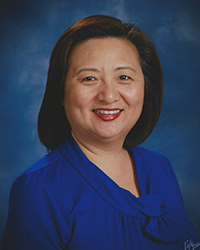
Bonnette-Kim knew that minority groups were at special risk. She was born in Korea. She immigrated with her family to Canada when she was 9 and later came to the United States to study for her master of divinity degree at Garrett-Evangelical Theological Seminary in Evanston, Illinois, where she met her American-born husband, Travis.
Like many Asian-born immigrants, she was disturbed by the way the pandemic prompted a rise of harassment and violence against Asian Americans, who were targeted after political rhetoric falsely blamed them for bringing the virus to the U.S.
Bonnette-Kim said she felt fortunate that she experienced no overt racism at her church. But during her seven years at Grace, she had shared with church members her personal and family experiences of harassment growing up, including her father’s suffering third-degree burns when someone threw scalding coffee in his face.
That history, coupled with the unsettled climate of the pandemic, made her double down on safety. She advised her father not to take walks on his own and joined him whenever she could.
And she found another tool to keep her family connected: Korean dramas on Netflix. Each afternoon, the family would gather to watch an episode — Bonnette-Kim, her husband and her father in Boston, along with her two daughters online.
With life beginning to return to normal, Bonnette-Kim is back at work learning about her new church, Carter Memorial United Methodist, a more affluent and less diverse congregation. She is Carter Memorial’s first clergy of color and only its second woman pastor.
So far, she said, people have been very welcoming. But she anticipates she again will have to educate her congregation about life as a person of color by sharing her life experiences with them. As an Asian American, she embraces that difficult work.
What community partners could bring needed services to your facilities so that people in the community would not have to find them on their own?
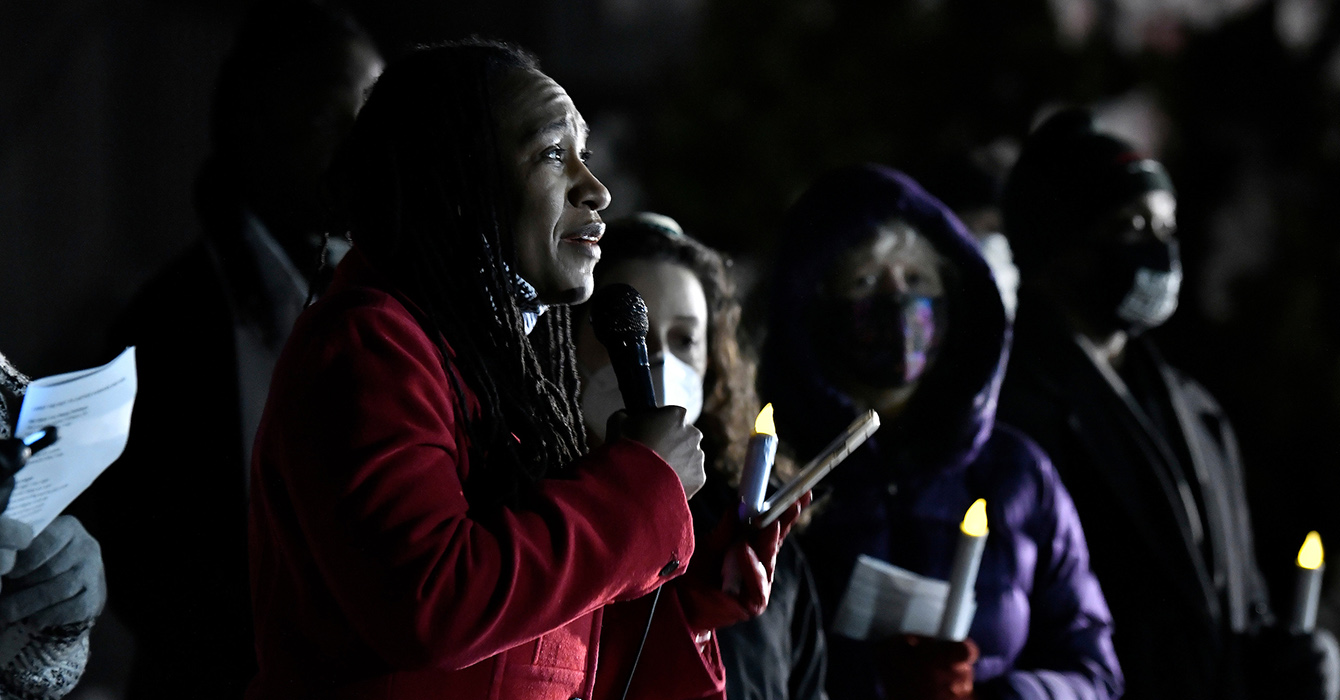
The Rev. Bernadette Hickman-Maynard: Moving forward by slowing down
Bernadette Hickman-Maynard has three big jobs.
She is the pastor of Bethel AME Church in Lynn, Massachusetts, about 10 miles north of Boston. She is a racial justice organizer with the Essex County Community Organization, a multifaith network of 40 congregations that advocates on issues such as policing and criminal justice reform. And she’s the mother of four young children.
She divides her time between the three, working three days a week for the church and three days a week for the community organization. Evenings she devotes to her family.
The pandemic made her realize that the only way to be present to all three is to find time for restoration.
Early on during the outbreak, she found that her 80 mostly elderly church members were needing a lot more assistance than usual.
“The older people wanted to be on the phone,” Hickman-Maynard said. “They didn’t know the technology. So I would have to call them individually. I had to alleviate their concerns, explain online giving and how we would do church in a pandemic. Conversations about the business of the church were elevated because of people’s fears and anxieties. People wanted more contact.”
Three of her elder church members died during the pandemic, one of COVID-19. In fact, it was an online funeral on Zoom in April 2020 — one month into the shutdown — that convinced her the church could successfully worship through Zoom with full participation from church members. Her husband, Theodore, who is also ordained in the AME Church, was able to help on Sundays with the music.
Following the death of George Floyd in May, her organizing work kicked into high gear. The community organization pressed for passage of a police reform bill that protects people of color from racial profiling and sets standards for police accountability.
During this frenetic time, Hickman-Maynard had two consolations. She was able to save time on the commute from her home in Randolph, about 30 miles south of the church, and her mother, who lives with the family, was able to help with cooking and attending to the children, each of whom goes to a different school.
Whom could you engage to help support you and your ministry in these trying times?
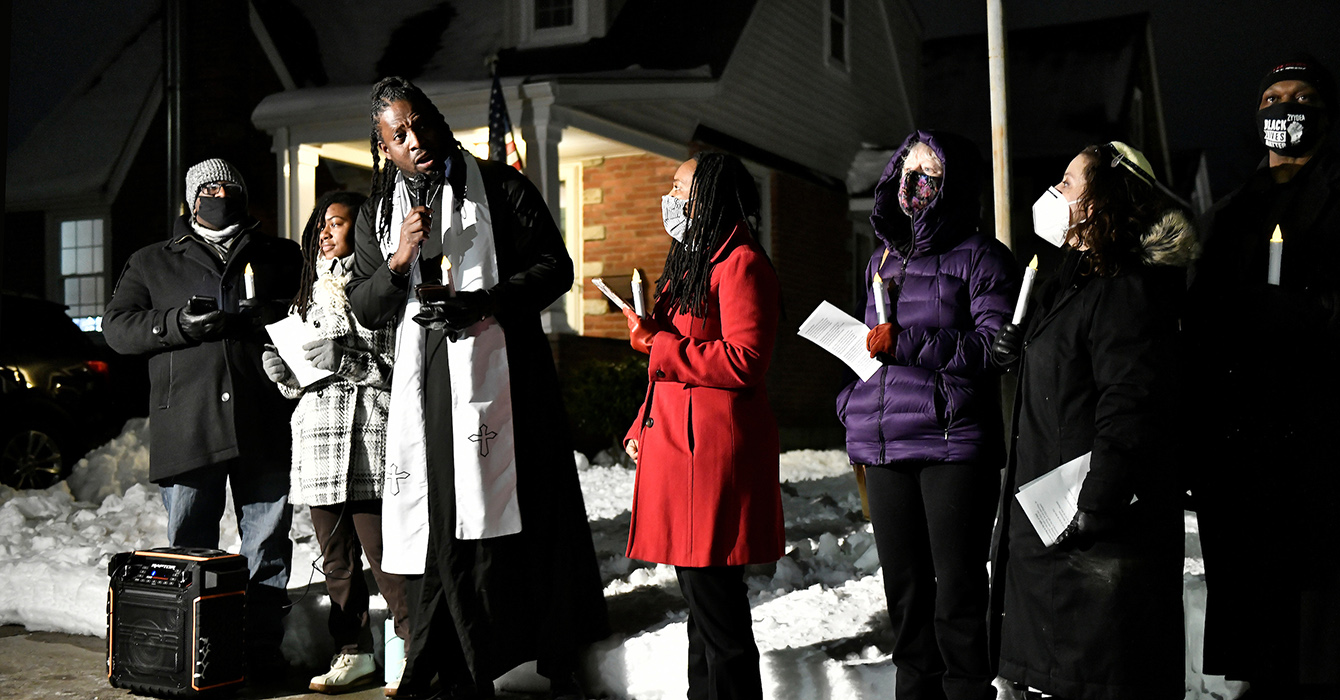
Still, juggling it all was not easy.
“I want to do this for the long haul,” she said. “That means I’m not going to be available for everything.”
She had stumbled upon Peter Scazzero’s popular books on emotionally healthy spirituality before the pandemic. The minister and marriage and family counselor teaches that the best way to move forward is to slow down and find time for rest.
Hickman-Maynard adopted his formula for rest, which consists of one day a week, one week a month and one month a year.
“It’s very hard, but it’s something I’m intentional about doing,” she said. “Because I’m able to take this time for myself and restore, it means I’ll be in the fight for the long haul and healthy while I’m doing it.”
How are you planning for your long-term health and restoration?
Questions to consider
- It may seem that a smaller congregation means less work, but this is far from the truth. What other assumptions are we making about smaller congregations and their pastors?
- How is your particular congregation marking this season of challenge and loss? Is your community offering spaces for congregants to process grief?
- In what ways does your congregation participate in the larger body of Christ?
- What community partners could bring needed services to your facilities so that people in the community would not have to find them on their own?
- Whom could you engage to help support you and your ministry in these trying times?
- In this season, it may be hard to think long term. Yet planning for a leader’s health and sustainability is still necessary for thriving in ministry. How are you planning for your long-term health and restoration?
The Rev. Jessica Ketola is an old hand at doing church. Her parents were pastors. She served as a worship leader for more than a decade. She recorded Christian praise songs. She ran a church nonprofit that tutored low-income neighborhood children.
But in her mid-40s, the Vineyard-ordained pastor decided to change all the rules.
In January 2017, after a season of upheaval at Vineyard Community Church, where she had been serving as an associate pastor, she relaunched the congregation in her Shoreline, Washington, living room.
Ketola called it The Practicing Church and explained her vision to the 25 or so members that remained: it would be a neighborhood-based church that would serve the community out of a commitment to Jesus’ way of love and a desire for God’s shalom, or peace.

“I had come to a place where I was weary of all the incongruence of the church,” said Ketola, 49, a married mother of four adult children. “I was longing for more authentic ways to express my faith.”
Four years later, worship services still take place in her living room — except temporarily during the pandemic, when it’s meeting Sunday mornings on Zoom. Although now double in size — about 50 people — it is still small but has made a big impact on the neighborhood of Richmond Highlands in Shoreline, a city of 53,000 on the Puget Sound north of Seattle.
Who lives and works in your neighborhood? What are the opportunities and challenges of that place? Who are potential partners for your work?
Instead of a singular focus on the Sunday service or a targeted missions project, The Practicing Church seeks to live Christian life in community.
Ketola did not come up with the vision for a church of the neighborhood. Her church is one of about 1,000 congregations loosely collaborating in the Parish Collective, a nonprofit that connects churches committed to living a life of faith in a particular location.
Borrowing from the Roman Catholic tradition of the parish, in which the faithful were assigned to the church closest to their homes (the Catholic Church no longer requires this), the collective seeks to revive the concept of the church as a geographic unit.
Members of The Practicing Church have picked up trash along neighborhood streets. They have volunteered on local task forces devoted to hunger and homelessness. They’ve offered cups of coffee to people outside a methadone clinic. They’ve started book clubs and a neighborhood garden.
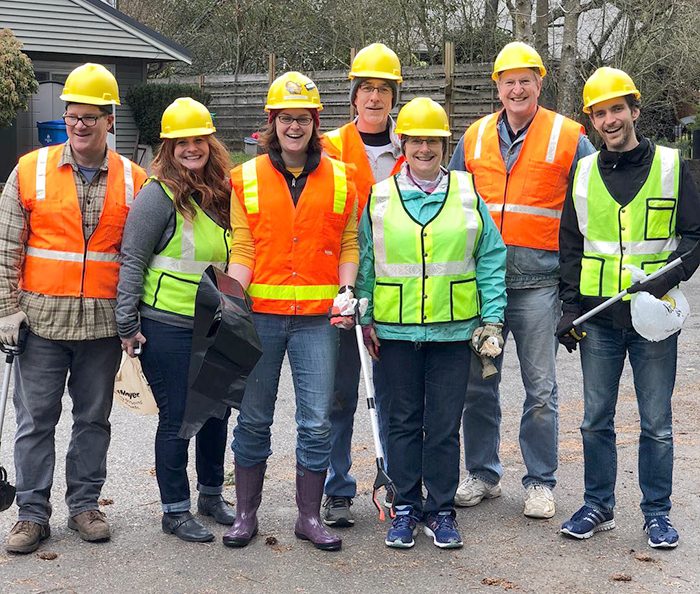
Equally important, they’ve gotten to know their neighbors. Until the pandemic hit, members held regular Wednesday night potlucks in Ketola’s home for anyone who showed up.
They threw a 70th birthday party for a man who was recently widowed. They organized a monthlong meal train for a new mother. They raised money to help an immigrant family settle into an apartment. They supported a Black-owned coffee shop. They secured housing for a homeless couple. When a neighbor’s sister died, Ketola invited the neighbor’s mother to stay at her house while they settled the family’s affairs.
Ketola’s reasoning is simple: “If the church doesn’t cause us to be kinder, more loving, more generous, more self-sacrificing, then what are we doing?”
And though many of the church’s regular social gatherings have been stalled this past year because of the pandemic, members say the lines of communication — though distanced — have remained strong.
“So many people don’t know their neighbors,” said Courtney Ewing, a 38-year-old engineer who considers herself part of The Practicing Church as well as a Free Methodist church she has been a member of for many years. “In our neighborhood, you know your neighbor — whether you want to or not.”
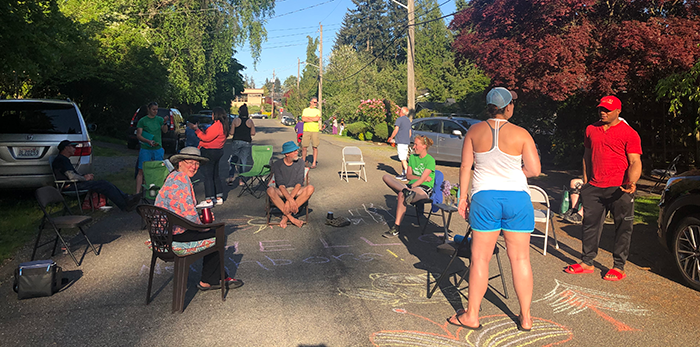
The church as a geographic unit
Tim Soerens, a pastor and social entrepreneur who co-founded the Parish Collective, said the idea arose in response to the increasingly consumer-driven ethic of churchgoing, in which Christians pick and choose a church on the basis of how much they enjoy the Sunday service or the pastor’s sermon.
What aspect of your Christian convictions about love and justice might come to life by focusing on the neighborhood?
Attending a service, Soerens said, is not the be-all and end-all of what it means to be part of a church.
“To use a sports metaphor, that’s close to a huddle,” he said. “It’s not the game. The game is a shared life and shared mission and a shared sense of responsibility on behalf of what God is up to.”
The Parish Collective envisions churches as teams of people living and working together for the flourishing of their neighborhoods. Soerens thinks even megachurches can divide into smaller groups that function similarly to parishes. (Only a tiny percentage of churches affiliated with the Parish Collective are house churches, like Ketola’s.)
Just as people are discovering the value of shopping and eating locally, Soerens says the church can discover the power of practicing its faith locally, serving as a kind of connective tissue that binds people for the sake of the common good.
That vision was especially appealing to Ketola, who in 2012 was struggling with her calling in a more traditional church. Then she learned about a certificate program offered through the Seattle School of Theology & Psychology called Leadership in the New Parish. There she met Soerens, Paul Sparks and Dwight Friesen, authors of “The New Parish: How Neighborhood Churches Are Transforming Mission, Discipleship and Community.”
“I didn’t really know what I was signing up for,” Ketola said. “I just knew we needed new ways of being the church. That started me on a journey. I began to have an imagination for leading a life of faith and love in my neighborhood.”
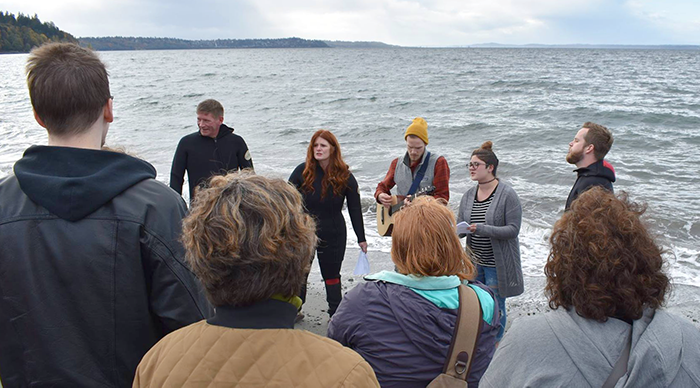
Falling apart before coming together
In truth, the church where Ketola was serving as an associate pastor was already searching for a new way.
Shoreline’s Vineyard Community Church, part of the charismatic Association of Vineyard Churches, was started in 1999 but had undergone a series of transformations.
Under the leadership of the Rev. Rose Madrid Swetman, now pastor emeritus, the church was searching for a better way to engage the Shoreline community. Like the Pacific Northwest generally, the area is known for its large swath of religiously unaffiliated people.
Shoreline, which is 69% white, 16% Asian, 8% Hispanic and 7% Black, was seeing a diverse influx of racial groups. Half the children in the city’s school district were nonwhite.
The church began partnering with human service organizations in the Seattle area. Eventually, it founded its own 501(c)(3) nonprofit, Turning Point Seattle, a tutoring program for children who receive free and reduced lunches at local elementary schools.
Swetman hired Ketola to direct the tutoring program and, a few years later, to assist her as the associate pastor at the church.
In many ways, Vineyard Community Church was a typical startup congregation. It did not own a building but rented space mostly from other churches. Most members commuted in from Seattle or surrounding towns. Ketola herself was living in Edmonds, a few miles north, with her husband and children.
If you live and work in different neighborhoods, how can you learn about the hopes and laments of people in all the places where you spend time?
But after completing the parish leadership certificate program, Ketola took her first step toward realizing her new vision for the church. She persuaded her husband that they should sell their home and move to Shoreline, where she was already serving on multiple task forces as part of her job running the tutoring program.
In 2014, the Ketolas settled into a 4,200-square-foot ranch home in the Richmond Highlands neighborhood. They positioned a baby grand piano in one corner of their new living room and a 10-foot-long dining table in another. The vision was coming together.
The church, however, was falling apart. Swetman developed congestive heart failure and stepped down as lead pastor. Many members left. Swetman and those that remained turned to Ketola for leadership.
She agreed to become their pastor and rebranded the congregation as The Practicing Church, borrowing the name from Swetman’s 2010 dissertation on church missions. (The dissertation still lives on the church website.)
“It was an incredibly painful period,” Ketola said. “But it helped us have the flexibility to innovate and do things differently.”
The gift of hospitality
In those first few years, Ketola thought the congregation would outgrow her living room. But after experimenting for several months with worshipping in a coffee shop, she decided that her home was a better venue.
The space naturally accommodated worship. Members didn’t have to rush to set up amps, microphones and musical instruments and then pack them up and haul them away. And each Sunday, Ketola baked gluten-free banana bread and brewed coffee. People loved the warmth and family-like feel of her home.
“I realized hospitality is one of my gifts,” she said. “We’re a family and a community, and that’s communicated by the context.”

In time, several members caught the vision and moved to Shoreline. (A few members still live elsewhere.)
Before long, the neighbors began to notice them.
What might happen if your congregation focused its ministry on neighbors? What might happen if place became the central factor in setting your priorities?
Ewing, the engineer, saw a posting for a Christmas party on the neighborhood social networking service Nextdoor.
“I thought, ‘Oh my gosh. Who are these people?’” Ewing said. “‘They’re opening their house to people they don’t know.’ Then I saw the address, and it was two houses down from me. So I decided to check out these crazy people who will invite anyone over.”
Soon, Ewing was dropping in on the Wednesday night potlucks. This past summer, she took part in an outdoor, socially distanced book group where members read Sandhya Rani Jha’s book “Transforming Communities: How People Like You Are Healing Their Neighborhoods.”
She is now working with Ketola on developing a map of the neighborhood’s assets, identifying people and organizations.
Not everyone who partakes in the work of the church is a member. Kathy Sutherland, who lives next door to the Ketolas, is not a churchgoer but has become an ally who thinks the church has made the community stronger.
“I’ve lived in the neighborhood for 35 years, and they know more people than I do,” Sutherland said. “That’s how they reach out.”

For Ketola, the goal is to work toward the flourishing of the community, not necessarily to make converts.
A bigger challenge is keeping the core team together in a hypermobile culture. Young families tend to move — for better housing options or better jobs. Three of the congregation’s core families moved to other parts of the country in the last few years.
What is the ultimate aim of your ministry? With whom and how do you assess progress?
The pandemic has paused the normal life of the church. In the summer and fall, some gatherings took place outdoors, with adjustments for social distancing and masking, but as the weather turned cold and rainy, that fell away. Instead of hosting a holiday party with karaoke at Christmas, church members delivered almond sugar cookies and holiday cards to their neighbors.
The tutoring program now relies on other volunteers, though Ketola still sits on the board and helps with fundraising.
In a recent Sunday morning Zoom session, some 13 families gathered to listen and sing praise songs. In her sermon, Ketola referred to the recent insurrection at the U.S. Capitol, pointing out that Christian nationalism is a form of idolatry and asking participants to reflect on what it means to be a Christian.
To her, it comes down to love of neighbor.
“You can look at so many of society’s ills as communities and fabrics of care that have fallen apart,” she said. “There’s been racial inequities, systemic racism, poverty, mental illness — all these things — because we’re not connected in community. We’re divested of place.”
Living out their faith day by day in their community, Ketola’s church aims to change that.
Questions to consider
Questions to consider
- The tradition of the parish is similar to modern business strategy in that both share a focus on a specific audience and place with the goal of improving impact. Who lives and works in your neighborhood? What are the opportunities and challenges of that place? Who are potential partners for your work?
- Parish Collective calls Christians to focus on the neighborhood and become a life-giving expression of the church in that place. What aspect of your Christian convictions about love and justice might come to life by focusing on the neighborhood?
- If you live and work in different neighborhoods, how can you learn about the hopes and laments of people in all the places where you spend time?
- Most American churches see ministry primarily as caring for members and missions as caring for the world. What might happen if your congregation focused its ministry on neighbors? What might happen if place became the central factor in setting your priorities?
- Jessica Ketola’s goal is the flourishing of the community. What is the ultimate aim of your ministry? With whom and how do you assess progress?
Over the past decade, a cadre of African American pastors have stepped up their commitment to environmental stewardship. One of the leaders of this movement is the Rev. Otis Moss III, the pastor of Chicago’s Trinity United Church of Christ.
After succeeding the Rev. Jeremiah Wright to become senior pastor of the 8,000-member South Side megachurch in 2008, Moss began to cast a vision for protecting the environment and retooling for resilience in the wake of climate change.
It wasn’t easy. Many church members grew up in an urban environment, far removed from that of their ancestors — many of whom were sharecroppers, and before that, worked the land as enslaved persons.
But over the past 12 years, Moss has led the church to plant the George Washington Carver community vegetable garden, which also teaches youth about gardening, and to start a Black farmers market.
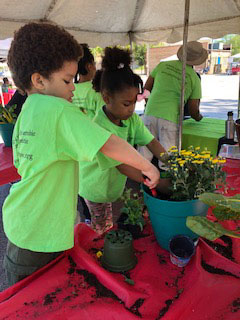
multigenerational project.
He helped raise millions of dollars to build a green roof — covered in vegetation to absorb rainfall and regulate temperature — that also incorporates solar power. In 2017, he dedicated the site of a 27-acre “green” intergenerational community called Imani Village.
Faith & Leadership contributor Yonat Shimron talked to Moss about the challenges of reconnecting to the Earth and its habitat. The following is an edited transcript.
Faith & Leadership: When did you first make the connection between care for the environment and your calling as a minister?
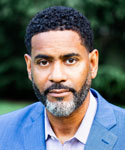 Otis Moss III: It began in connection with my home church in Cleveland, Ohio. I was at Olivet Institutional Baptist Church, where my father pastored. My father was from Georgia, right outside LaGrange. As the son of a sharecropper, he was tied to the land and had a special affinity for the land and what we would call today holistic health.
Otis Moss III: It began in connection with my home church in Cleveland, Ohio. I was at Olivet Institutional Baptist Church, where my father pastored. My father was from Georgia, right outside LaGrange. As the son of a sharecropper, he was tied to the land and had a special affinity for the land and what we would call today holistic health.
That continued with my relationship with my wife, who is also from the South. Her family had a deep tie to the land and the lessons she learned from her grandmother. They lived on a peanut farm. Part of her ethic was, “You take care of the land; the land takes care of you.”
Coming to Chicago, we realized the great migration had created a break. People who had deep connection to the land were disoriented and living in spaces of rapid urbanization. When we took hold of a piece of property across the street from the church to create a garden, that was a catalyst for us moving in a green and sustainable direction.
F&L: What was that piece of property like?
OM: It wasn’t much of anything — just a little lot. We turned that into a community garden with a small grant from a group called Faith in Place. We received another grant to train young people to be gardeners and hired a master gardener to be their teacher.
From there, we expanded to a farmers market and built a relationship with a coalition of African American farmers in Pembroke, Illinois. Pembroke is primarily a rural African American community where the first people of African descent migrated from North Carolina, prior to emancipation, for a better life.
We built a relationship with this community where you had fourth- and fifth-generation farmers living in this area.

From there, we made a decision to be a sustainable church.
When we reached the point where we needed to do a church renovation, we made the decision it would be a green renovation. We would seek to hire returning citizens who were formerly incarcerated. The contractors would be from our community.
Those were the principles we used: green, dismantling mass incarceration and economic empowerment.
F&L: Was it a hard sell for the congregation? Did you have to convince the board of directors?
OM: There’s a funny story around that. I remember the first presentation I gave to the congregation. It was pretty quiet. Many times when people are quiet, people are thinking to themselves, “I’m not going to support this, because I don’t understand what the minister is talking about.” They have to take it home and sit with it.
I went to go get my hair cut later that week, and my barber told me that one of the elders came into the barbershop and was fussing about the new minister and his church.
We had been talking about doing a green roof. The person in the barbershop was quite upset with me for wanting to put a putting green on top of the church.
When he heard “a green roof,” he only associated it with a putting green on top of the church. He didn’t have any concept of what a green roof was.
Because of that encounter, I went back to the board of directors and said, “We made a huge mistake. We have not educated the congregation appropriately. They have no idea what we’re talking about.”
From there, we instituted an education program with small groups, sharing, “What does green mean?
“Your grandmother was green because she had a quilt that recycled pieces of cloth. Your grandmother made gumbo, which is essentially a culinary form of recycling. Your grandmother grew food behind the house and you never went without.”
Once we did that and the elders had the language and vocabulary, it was easy to make the next step. They became the ambassadors for it: “We must go green. This is our responsibility and our heritage.”
F&L: Do you now encourage other churches?
OM: We do. I’ve been asked multiple times to give presentations about our work. Our community development corporation became evangelistic for green design, sustainable design and partnering with organizations that put to work people who are returning from prison.
We were part of the renovation for our local library, several blocks down the street, the Carter G. Woodson Regional Library. It’s a repository for African American literature in the Midwest.
The building was falling apart. We wanted a green renovation using people from the mass incarceration system and contractors from our community.
We were able to negotiate with the city — it was about 10 different organizations that got together — and we were able to receive $10 million from the state for a full-service renovation that was green.
It’s the crown jewel of our community. It’s a beautiful structure now that was built and organized by community partnership.
Then we purchased 27 acres down the street and we built a medical facility. We’re planning housing, along with an urban farm and workforce development with people coming out of mass incarceration, and a fitness facility. And the entire design, from the ground up, is a green design.
It’s in partnership with the Nature Conservancy, and we’re putting together what’s called a healing garden, which will be a beta test for prescribing nature over traditional chemical medication.
It’s a new way of looking at revitalizing and building communities in areas that have traditionally had no investment or have been divested over the years.
F&L: African American churches are dealing with so much right now — police brutality, health disparities, unemployment. Have you seen this issue gain much traction?
OM: The challenge in America and in the West in general is that we compartmentalize issues. Environment is over here; mass incarceration is over there.
But we approach it all as intertwined.
If you live in [some sections of] Chicago, you live in a food desert. You have corner stores. The reason you have corner stores is because no one has invested there or these areas have been redlined due to government policies.
These corner stores do not serve healthy food. They serve highly processed food. That then becomes the diet for children in that area.
Then they’re diagnosed by a public school system with attention deficit disorder or some other type of challenge that needs to be fixed by medication. It’s directly connected to how children are perceived in our community.
We do a lot of work helping people see the connections between a food desert and mass incarceration and economic disparity and the way police are deployed to occupy rather than being community partners.
All of it is interconnected with systematic racism. And helping people see the connection, they then understand, “Oh, creation and the land is also connected to my transformation and liberation.”
F&L: Have you seen congregants make changes in their lives?
OM: We use our farmers for the food that’s prepared at the church so you know where it’s coming from. We push this idea that you should know your farmer. When you invest with a farmer, you know his or her entire family.
You have this community that’s created where people are witnessing children learning about farming and building a relationship with a person who’s raising the food.
A change in eating can also change a community, economically and socially. There is now data that shows that community gardens reduce violence in impoverished neighborhoods. It’s a pretty simple reason: community gardens create community.
They have people working in the gardens who get to know each other. They become quasi block clubs and watch clubs. People become interested in each other and their challenges and celebrate their victories together, all because we put our hands in the same soil.
F&L: How do you tie it in to the Christian message?
OM: The exodus story is near and dear to people of African descent. We see ourselves in the exodus story. Moses tells Pharaoh to “let my people go” — not “that we may build an ark,” but “so we may go to a land where we may worship God,” where we may have this relationship we used to have prior to the enslavement moment.
We share that narrative that we are displaced, that we have been disoriented from the land. Exodus is about reorientation and the Jewish people becoming landed people from a landless people. We share that same narrative.
When we move to the New Testament, Jesus is a country preacher, a rural preacher. Paul’s urban; Jesus is a landed preacher.
The parables are told from the perspective of someone who knows about the land. That’s why you have a parable of seed falling upon the land or the parable of the prodigal son, of someone who has been hired out to care for pigs.
They are rural stories, stories that connect people to the land.
The Bible is rich in imagery that connects us to the land. There’s a list of 100 scriptures beloved by people of African descent. Many of the most beloved are those that are landed.
For example, the Twenty-Third Psalm speaks in rural language. The Isaiah text of “they that wait upon the Lord shall renew their strength; they shall mount up with wings as eagles” (Isaiah 40:31 KJV) speaks, again, out of this landedness. The Amos text of justice rolling down like waters (Amos 5:24).
The creation metaphors, the rural metaphors speak to a community that still has a deep memory of being in the South migrating to the North, but it still rings so true to us.
More than 50 years ago, a church member with a love of children badgered the Rev. Randall Lolley about the congregation’s underused space: “We can’t have these rooms sitting empty,” Mitzi Moore told him. “I think we should start a school.”
Scattered among the church’s three large buildings that cover an entire city block in Winston-Salem, North Carolina, were 49 Sunday school classrooms.

In those days, First Baptist Church on Fifth, one of the city’s most stately and historic congregations, had more than 2,000 members and had grown to encompass 114,000 square feet of space, including a gym and a chapel. Yet even then, classrooms stood empty during the week.
Lolley, one of the most forward-looking pastors of the era, agreed with Moore, and the church founded the county’s first racially integrated day care for children ages 8 weeks to pre-K (plus an after-school program for children through age 12).
This month, the five-star center will close as the church prepares to tear down two of its buildings in a revitalization effort aimed at pushing a now much smaller congregation into the 21st century.
After months of investigating options for keeping the center open or moving it to a new location, the church could find no viable solution for its signature ministry, which it subsidizes with $100,000 a year.

Scores of mainline Protestant and Catholic churches are making similar, often painful choices. Faced with crumbling infrastructure and costly maintenance that consumes an increasingly large slice of church budgets, congregations are looking to downsize and at the same time reimagine a different vision for ministry.
“We spend so much money just keeping the lights on,” said the Rev. Emily Hull McGee, the First Baptist pastor. “We’re significantly impeded from doing new things — being creative, hiring new staff, giving more money away or finding new partnerships — because so much of our annual budget is going to the building.”
What is the cost to your organization of — metaphorically or literally — “keeping the lights on?”
Church building experts see this happening across the nation. In their zeal to build, post-World War II Americans left future generations with hulking edifices that now stand as testaments to outsize ambition.
These days, groups such as the UCC Church Building & Loan Fund, the oldest society of its kind in the U.S., do more consulting than church financing. About two-thirds of the loan fund clients are congregations figuring out how to repurpose, reuse or rethink their buildings.
“Most churches have an upside-down relationship with their building,” said the Rev. Patrick Duggan, the executive director of the Church Building & Loan Fund.
What kind of relationship does your organization have with its buildings or other facilities?
“The building becomes the important thing to hold on to. It’s an unfortunate thing when that happens, because it’s a small group of people who can’t afford the upkeep on a building trying to figure out every way possible to keep it going, and that becomes what church is.”
At First Baptist Church, members are righting that ship. They have slowly but decisively concluded they must raze two later additions, including the brick edifice that houses the Children’s Center, while repairing and upgrading their original sanctuary building.
This Advent season, they are taking stock of their assets and trying to imagine what purpose and mission will carry them into the next decade. For many in the church, it is a time of waiting.
The Camelot years
As its name suggests, First Baptist has long been a trailblazer.
Founded in 1871 at a time when the region had more Moravians and Methodists than Baptists, the church was instrumental in birthing Baptist churches in every quadrant of the town. One of its early pastors, H.A. Brown, helped organize the local Baptist association, which led the founding of several dozen more churches.
The current sanctuary, completed in 1925 in the Greco-Roman style, is round and seats 1,200. Green Corinthian columns support a soaring domed ceiling.
“When it was built, it was considered the finest church building anywhere in the Southeast,” said Paul McCraw, the church historian. “People came from everywhere to see it.”
The church reached its apex in 1957 with 2,800 members and another 700 nonresident members.
It had already built Building B to accommodate all those members, and in 1961, it completed Building C. Not only did the church open the first downtown gym; it also hired a minister for youth and recreation — a novelty in those days.
Older members have fond memories of the gym.
Gayle Edwards, 73, who grew up in the church, remembers “community night on Fridays, where people could come in and skate.”
“Basketball teams played there,” she said. “We had lock-ins, birthday parties.”
Beginning in 1967, the church also had the Children’s Center. The yearly budget paid for the upkeep of the center, including utilities and cleaning services. Tuition paid for the teachers’ salaries and supplies.
Most of those enrolled in the day care were not the children of church members, but the congregation kept its commitment to the town’s black and white working families. Most people in town would have known First Baptist on Fifth principally because of the Children’s Center at a time when so few offered such a service.
Yet despite its vibrant pastor, who went on to become president of Southeastern Baptist Theological Seminary in 1974, the church’s Camelot days were ending.
Though Baptists are still the largest denomination in North Carolina, downtown churches such as First Baptist, which is affiliated with the moderate Cooperative Baptist Fellowship, have seen a 40-year decline, as suburban churches often overtake them in numbers.
Today, its $1 million annual budget includes $340,000 to keep up its facilities. Utilities cost about $10,000 a month.
The downtown has newer, more modern gyms, and the church is no longer a hub for family outings. The buildings — with their linoleum floors and fluorescent lights — have fallen into disrepair, evident not so much in their physical appearance as in their internal workings: the boiler, the roof, the masonry are all in need of major upgrades.
As important, the church has far fewer members — some 500 active members (and another 700 inactive members). Sunday worship draws about 220.
Can you identify assets that your organization possesses? Which ones fit with your current mission? Which do not?
Earlier this summer, church members voted nearly unanimously to tear down the two buildings.
“It would be easy for folks to say, ‘Well, we’re losing a gym. We’re losing a chapel. We’re losing all this space,’” said Gary Knight, who chairs the special committee on facility and mission. “But I felt good that people recognized we have an abundance of other assets.”
First Baptist Church is ready to lead in new ways.

New leadership, new vision
When she arrived two years ago, McGee knew the buildings were in significant disrepair.
The copper dome atop the historic sanctuary was leaking; water damage from the roof was causing the plaster in Building C to flake off; the masonry on the terra cotta and limestone cornices was crumbling; and the boiler serving all three buildings needed to be replaced, as did the underground pipes.
During her interviews for the senior pastor position, McGee learned that the church was already discussing the campus’s sustainability. A research group had been formed to study the facility, and its members recognized that the church was at a crisis point.
Is your organization at a crisis point? How would you recognize such a moment, and how would you respond?
“When I came in, I knew the facilities were a problem and that I would need to tackle it pretty quickly after I got here,” she said.
The 36-year-old mother of three is the church’s first woman pastor. And she is uniquely qualified for the role.
Her grandfather, William Hull, was dean of theology at Southern Baptist Theological Seminary in Louisville, provost at Samford University in Birmingham and longtime pastor of First Baptist Church in Shreveport, Louisiana.
Her father, David Hull, was pastor of First Baptist Church in Huntsville, Alabama. He now teaches and consults while his wife, Jane, McGee’s mother, serves as pastor of Union Christian Church (Disciples of Christ) in Watkinsville, Georgia.
Pastoring is in McGee’s DNA. Still, shepherding First Baptist in a new direction weighed on her.
The research group had already suggested tearing down one of the buildings. But its report was not binding, and McGee quickly formed a new committee to bring a recommendation to the membership for a vote.
That committee set out to examine all options.
“We all started thinking we’d figure out some way to save all the buildings,” McGee said.
But the results of an engineering study made it clear to committee members that the challenges were significant. Repairing all the buildings and bringing them up to code would cost $8 million to $10 million.
And as committee chair Knight pointed out, “Even if we had unlimited resources and the ability to renovate the entire campus, it still left us with buildings that don’t meet 2017 needs.”
Critically, the repairs would not save the Children’s Center.
The state now requires day care facilities to be on the ground floor with an exit from each classroom. The current day care, which takes up two floors, is grandfathered in. If the church were to renovate the facility, it would have to rebuild the day care from scratch.
The committee spent months trying to find an alternative solution for the Children’s Center. It talked to outside partners. It studied other day cares. It priced a free-standing building. It looked at moving the center to one of the other church buildings. No viable solution emerged.
“Looking at things in a vacuum, you could say, ‘Isn’t there a critical need for day care?’” Knight said. “But what we came down to was, you could either have the church or have the children’s center. It was the toughest part of our work coming to that conclusion.”
Although the congregation largely supported the decision, they did face pushback from families whose children attend the day care.
“There were a ton of tears shed this morning,” Meg Shipley, a parent, told the local newspaper upon hearing that the center would close this month.
Ultimately, what brought life to the committee was shifting from the idea of trying to save the buildings to that of tearing them down and renovating the sanctuary building.
Winston-Salem’s downtown has been undergoing a revitalization. It now has nearly 4,000 apartment units — more than half built over the past decade — and many more in the works. Several top hotel chains have announced plans to open.
Is there momentum in your community toward growth and thriving? How could your organization be a part of it?
What if First Baptist were to tear down its crumbling buildings and be part of that revitalization?
“It felt like we were freed of a weight that was holding us down,” said McGee. “It’s as if that just freed us to think creatively about our space.”
From that point on, the committee focused its efforts on presenting the church with a scaled-back plan for a smaller campus — minus buildings B and C — that would meet the needs of a smaller but more nimble congregation.
On a Wednesday night in November, after a supper of lasagna and garlic bread, Knight, the committee chair, and McGee unveiled a PowerPoint presentation for a $5 million to $6 million renovation of the sanctuary building and the addition of a 4,200-square-foot glass atrium to the rear of the building, as well as an outdoor garden.
The atrium would accommodate shared meals, celebrations and community events. (Demolition of the two buildings, included in the total, would cost between $250,000 and $500,000.)

Still ongoing are discussions about the church’s identity minus the Children’s Center, which has defined First Baptist for so long.
In conversations during November, the church began the process of envisioning a new mission.
Perhaps the church could start a music academy for children, stage public concerts on the front steps of the building, offer Bible studies for young people downtown or partner with the Benton Convention Center one block away.
To mark the passage into a new vision, McGee suggested a history wall or mural to be filled with images, artifacts and a timeline that might help the congregation tell its story. The church could even commission artwork for the renovated structure using materials from the buildings that will come down.
Church members want to continue the mission Mitzi Moore proposed in the 1960s with the introduction of the Children’s Center. It won’t be a day care, but it will probably involve children.

“Children,” Edwards said, “will always be important to the church.”
For now, church members are captivated by the possibilities. Those include a smaller footprint but a deeper sense of community, a more modest budget but an openness to creating new ministries.
In January, the committee is expected to present the congregation with a new mission, vision and values statement.
This Advent, it is waiting for that vision to be birthed.
Questions to consider
Questions to consider
- What is the cost to your organization of — metaphorically or literally — “keeping the lights on?”
- What kind of relationship does your organization have with its buildings or other facilities? Is it “upside down?” If so, how might you begin to right it?
- Can you identify assets that your organization possesses? Which ones fit with your current mission? Which do not?
- The Rev. Emily Hull McGee learned the church was at a “crisis point” when she arrived, and that she needed to lead out of it right away. Is your organization at a crisis point? How would you recognize such a moment, and how would you respond?
- First Baptist decided to join in the revitalization of downtown Winston-Salem. Is there momentum in your community toward growth and thriving? How could your organization be a part of it?

